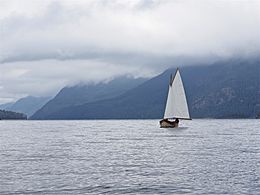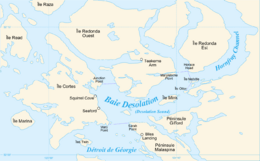Lewis Channel facts for kids
Quick facts for kids Lewis Channel |
|
|---|---|

Lewis Channel
|
|

Lewis Channel is located between Cortes Island and West Redonda Island
|
|
| Location | Discovery Islands, British Columbia |
| Coordinates | 50°11′00″N 124°55′25″W / 50.18333°N 124.92361°W |
| Type | Strait |
| Ocean/sea sources | Salish Sea |
Lewis Channel is a narrow waterway, like a natural river or passage, located in the beautiful Discovery Islands of British Columbia, Canada. It acts as a connection between larger bodies of water and is a part of the northern Salish Sea. This channel is an important route for boats and ships traveling through the area.
Contents
What is Lewis Channel?
Lewis Channel is a type of waterway called a strait. A strait is a narrow passage of water that connects two larger bodies of water. Think of it like a natural shortcut for boats! Lewis Channel is found between two islands: Cortes Island and West Redonda Island. These islands are part of the Discovery Islands, a group of islands off the coast of British Columbia, Canada.
Where is Lewis Channel Located?
This channel is a key part of the northern Salish Sea. The Salish Sea is a large network of coastal waterways that includes the Strait of Georgia, Puget Sound, and the Strait of Juan de Fuca. Lewis Channel helps connect different parts of this big water system.
Connecting Waterways
Lewis Channel links Desolation Sound to the south with Calm Channel and Deer Channel to the north. This means it's a busy pathway for boats and ships moving between these areas.
Nearby Features
A special part of Lewis Channel is Teakerne Arm. This arm branches off to the east and forms a large, protected bay within West Redonda Island. It's a popular spot, and you can find Teakerne Arm Provincial Park there, which is a great place to visit. The channel itself does not have any major islands inside it.
The Salish Sea Connection
Lewis Channel is important because it marks part of the northern edge of the Salish Sea. This means it helps define where this large and important body of water begins and ends in the north. The Salish Sea is home to many different kinds of marine life and is a vital ecosystem.


